1/48 Hobbycraft T-33/TV-2D Naval T-bird
My last build was an extensive reworking and upgrading of the 1/48 Monogram F-8E Crusader. The kit fought me the entire time, plus I made a lot of frustrating mistakes. So this time, I wanted a quick, relaxing, trouble-free build, before moving on to something more challenging for my next project. The 1/48 Hobbycraft T-33 seemed like just the right kit - simple, not many parts, and no major modifications necessary. I had previously purchased the Iliad Designs decal sheet of Naval T-birds, so I planned to finish the kit as a TV-2D, the Navy's version of the T-33 used for controlling Regulus missile flights and other fleet utility work. The Navy's eye-catching drone controller paint scheme has always been a favorite of mine, so I was looking forward to building another drone controller for my collection. I build only 1/48 Navy and Marine Corps aircraft, and every so often I like building aircraft from unusual units, rather than standard fleet squadrons. A TV-2D from Guided Missile Group One would be a good change of pace from my recent builds of Hellcats and Crusaders.
But was I wrong about this being a quick, relaxing, trouble-free build. Just about anything that could go wrong, did. But more about that later.
The 1/48 Hobbycraft 'Korean War' T-33 had been in my stash for years. It has average to poor fit, scribed panel lines, and mostly accurate outline and shapes. Once I closely examined the parts, though, and saw that most lacked detail, I considered buying the Great Wall T-33. But then I reminded myself this was supposed to be a quick, relaxing, trouble-free build, and decided to go ahead with the Hobbycraft kit. The biggest accuracy issue seems to be the aft fuselage, which has a humped appearance just before the tail. The rear canopy fairing where it meets the fuselage is the wrong shape as well. Otherwise, the kit looks enough like a T-33 to me to pass muster. The only options the kit gives you is to display the canopy open or closed, to add pylons and bombs beneath the wings, or to have nose guns visible or replaced with blank-off plates. (I used the blank-off plates, since the TV-2D I was modeling was unarmed.) The flaps are designed to be displayed down, but could probably be trimmed to fit closed. The tip tanks are (I think) the Misawa type, that hang under the wingtips. The jet I was building, though, had the longer Fletcher-type tanks that attached directly to the end of wingtips. Fortunately, I had a pair of Fletcher tanks in my spares box left over from an old Testor T-33 kit.
The kit cockpit is very basic, and the two-part ejection seats only vaguely resemble actual T-33 seats. I like to build my kits with the canopy open, so a replacement was in order. Years earlier, when I purchased the kit, I also got the True Details cockpit set to dress up the anemic kit cockpit. I primed all the cockpit pieces with Tamiya white primer in a spray can, then airbrushed the cockpit Tamiya acrylic NATO Green. I added wire ejection pull handles to the seats, and painted them black with yellow stripes. The seats themselves were painted Tamiya acrylic NATO Black, with Model Master Acryl Insignia Red headrests, and Model Master Acryl Light Grey belts and harnesses. A fellow modeler told me that the Regulus missile drones were flown from the front cockpit of TV-2D's, so I guesstimated and added a side control stick to the right console, along with a few additional instruments and boxes. I couldn't find out if these jets retained the main control stick in the front cockpit, so I left it in. The kit instrument panels had better detail than the True Details panels, so I used them instead. I used Repli-Scale decal instruments for the instrument panels, and generic white stenciling for the headrests. The torsion links on the struts are solid, so I drilled them out for a more accurate appearance. The kit wheel wells are bare, so I added a few lines and cables from wire and styrene rod. Nothing major, just enough to busy up the wells some. I did replace the molded-on brake lines on the main gear with wire for a more scale appearance. The flaps have molded-on rib detail, but it's not very pronounced. I left them as is, but added ribs and stringers to the upper flap wells, which had zero detail. I also added sheet styrene to the fuselage to cover huge holes visible when the flaps are lowered. The splitter plates, which are supposed to go inside the intakes, did not fit well at all. I adjusted the fit by trimming part of the plate, but they still fit very poorly.
Here's where the problems started.
I glued a large fishing weight in the nose to keep the kit from being a tail-sitter, then glued the fuselage halves together, along with the horizontal stabilizers. The horizontal stabilizers didn't fit well and needed lots of filling and sanding to get a smooth joint. Despite repeated careful test-fittings, I managed to glue the cockpit in off-center. The left side of the cockpit sits about 1/32nd inch lower than the right. Of course I used super glue which set instantly, and I didn't notice it until I had the fuselage halves glued together and the wings on. On top of that, the front instrument panel sat way too low, leaving a huge gap at the top. I broke it loose to reposition it, and it fell inside the fuselage. I thought it was gone forever, but after an hour or so of shaking the plane upside down, it finally fell out. When I repositioned it, there was still a gap between the top of the panel and the cockpit sill. Sacrificing accuracy, I ended up adding a small row of instruments to cover this gap. The wings did not fit well either, leaving gaps at the wing root and lacking the correct dihedral. I added spacers to correct the fit and eliminate the gaps, but the wings still don't have enough dihedral.
Masking, painting, and decaling turned out to be the most exasperating parts of the entire build.
After assembling the fuselage and wings, I masked off the canopy and windscreen and primed the plane with Tamiya white primer. Then I realized I made my first of many painting mistakes: I forgot to paint the canopy and windscreen black first, before I used the primer. Now I had beautiful white frames on the inside of all of my cockpit glass, instead of black. I'd have to correct that later. I then sprayed the fuselage and rear half half of the tip tanks ModelMaster Acryl Navy Gloss Grey. The masking was extensive and tedious - the tip tanks had to be painted four colors: Flat black on the inside halves, and Insignia Yellow and Navy Gloss Grey on the outer halves, and natural metal on the tank tips. I then sprayed the forward outer halves of the tip tanks and the fuselage. My first two attempts at spraying this color were disastrous. The paint was very thin, and splattered all over the fuselage. I had to sand and strip paint twice on the fuselage to get it to look OK. I ended up airbrushing it with no thinner, just straight from the jar. The tail and wings were then sprayed ModelMaster Insignia Yellow, and I had better luck spraying this color. The inner halves of the tanks were then sprayed Tamiya acrylic NATO Black. I should have checked my reference photos more carefully, because when I did, I realized I made two more big mistakes: First, I painted the entire bottom wing yellow, when the center of the bottom fuselage should be Navy Gloss Grey. Second I painted forward outer half of the tip tanks yellow at the mid-point line, when the yellow should have been even with the leading edge of the wings. So I had to re-mask and repaint these areas. When I removed the masking, I discovered that the grey paint had seeped through onto the yellow on the wings. Again, more masking and repainting. Despite priming, when I removed the masking form the fuselage, the tape pulled up small chunks of grey paint. I re-masked the damaged areas with Post-It notes and repainted. The leading edges of the wings and tail surfaces are coated bare metal, so I masked them off and painted them Tamiya acrylic Flat Aluminum. When I removed the masking, I was relieved to see that no paint had seeped, there was no overspray, and it looked good. But then I realized I should have masked farther back from the wing leading edges. The metal portion looks way too thin. By this point I was too frustrated to re-do it and moved on. For the walkways, I decided to use a black decal sheet cut to the appropriate size. After applying them and using Solve-a-set to melt them on, I looked at the photos of my jet and realized I made the walkways way too wide. Another error I decided not to correct.
I hand-painted the incorrect white frames on the inside of the canopy and windscreen NATO Black, then added a single rearview mirror to the upper right side of the windscreen. I wanted to add the canopy locking mechanisms, so I fashioned some from small triangles of sheet plastic, then sanded down the points. But I made another mistake - I studied photos of T-33 canopies to make the latches, but added just three to each side, when there should be four.
The Navy drone controller scheme calls for a Navy Gloss Grey fuselage, with Insignia Yellow tail and wings, with three-foot-wide stripes of either International Orange, Insignia Red or Day-Glow Orange-red on the wings. The jet I was building had orange wing stripes. The Iliad decal sheet has a couple of errors: they show the entire fin and stabilizers being yellow, but photos show the rudder on this jet should be International Orange, and the fin cap should be painted light grey. I somehow managed to mask and paint these areas without incident. I followed the decal sheet instructions on painting the International Orange bands on the wings, but after careful study of three existing photos of this jet, it's apparent the orange wing bands should be farther out on the wings.
I sprayed the landing gear, gear wells and inner flaps and flap wells Tamiya acrylic NATO green. The wheel hubs were painted Metalizer Steel, with Tamiya Chrome Silver oleos. But later I found photos of a couple of Navy TV-2's that have white landing gear. I didn't have any photos of the gear on the jet I was building, so I didn't repaint mine. The exhaust pipe was hand-painted with Metalizer Jet Exhaust.
Aside form the errors on the Iliad sheet, the decals are great and went on well - except for another huge blunder on my part. When I was applying one of the service/unit designator decals on the fuselage, I accidentally applied Micro Liquid Decal Film instead of Micro Decal Set. I brushed some on the fuselage, then applied the decal - it instantly melted, the white ink from the decal running down the sides of the fuselage, staining it. The two solutions are in similar bottles, and I wasn't paying attention and dipped my brush in the wrong one. I had to scrape off the ruined decal, and mask and repaint the fuselage - again - where the ink from the decal stained it. The red intake warning triangles on the Iliad sheet that go on each side of the intakes looked too dark, almost a maroon color. This was way too dark, especially on the grey fuselage. I decide to make new ones of the proper bright red color with spare intake warning decals from spare F-8 Crusader decal sheets, and cut them to fit. This turned into a major headache: the first sets of decals either broke apart in the water, or tore apart when sliding them into position. After burning through four sets of intake warning decals, I finally got it to look right. The red turbine warning stripe isn't included on the decal sheet, and it's readily visible on photos of the jet I was modeling, so I raided my spare decal catalogs and came up with one that I applied to the appropriate place on the rear fuselage.
By now, I was ready to launch this model on an unmanned, high-speed test-flight into the wall. But it had become a battle of wills, and I was determined to beat this kit into submission.
For the tail position light, I drilled out a small hole at the base of the rudder, painted it silver inside, and added a drop of Krystal-Clear for the lens. The wingtip and tank lights were replaced with clear resin pieces, then colored with Tamiya Clear Red and Clear Green. I added a red anti-collision light under the center of the fuselage. I also used Krystal-Clear to make the two landing lights on the nose gear strut. In researching T-33's for this project, I read that all T-33's had a green-tinted center windscreen panel, so I used thinned Tamiya Clear Green to replicate this on the kit windscreen. The kit had no pitot probe, so I made one from a probe found in the spares box, bent and sanded to shape, and attached it under the nose.
Finally, I added antennas for drone-controlling on the top and bottom of the nose. The tall blade antenna on top came from a 1/48 Hasegawa A-4 kit, and the smaller bottom antenna came from a 1/48 Hobbycraft A-4 kit. I used a sharpened mechanical pencil to lightly enhance the panel lines on the wings and tail. But otherwise, I kept weathering to a minimum, mainly because I just wanted to get the damned thing finished. It's certainly not a contest winner, but I'm calling it done.
A quick, relaxing, trouble-free build, remember? Yeah, right...
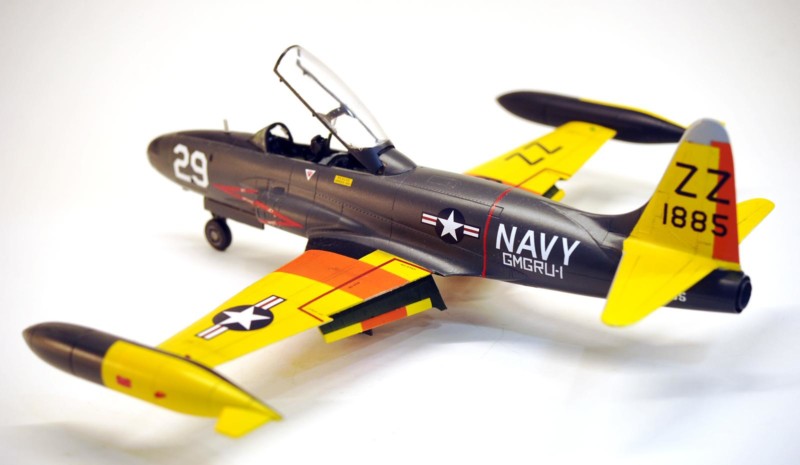
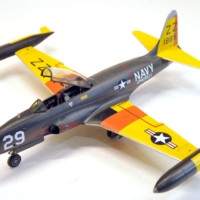
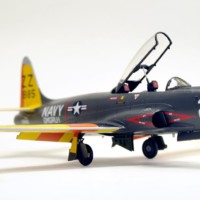
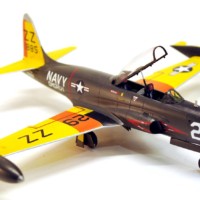
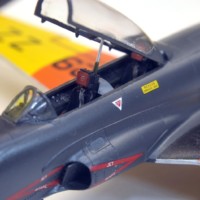
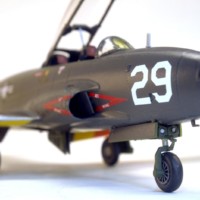

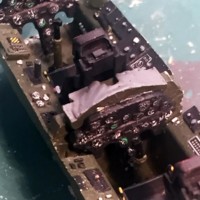
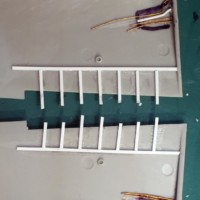
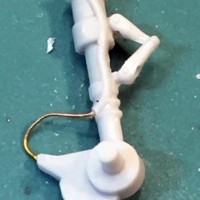
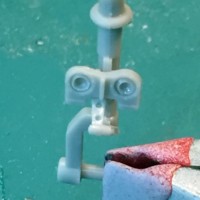
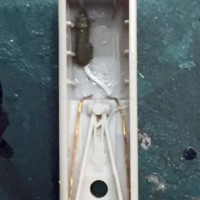
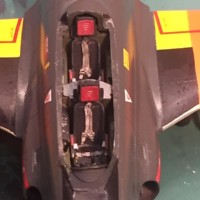

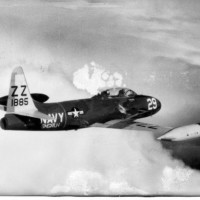
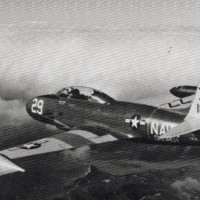
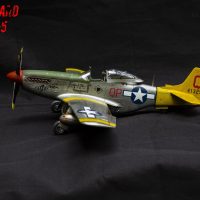
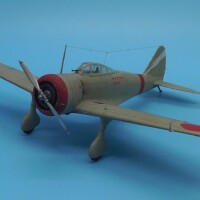
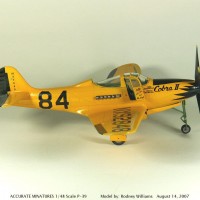

Thanks for the insight Drew. I think many of us go through these experiences and don't express them as well or as openly as this!
For all of the trials and tribulations you have mentioned it looks great - very clean and really well done. I really really like it!
Thanks, Paul! Most of the problems were careless mistakes on my part, but I am rather pleased with how it turned out.
Very informative narrative/tutorial...and I love that colorful paint scheme as well. Nice all around job, Drew.
Thanks Craig! I always appreciate your comments.
A triumph of talent (and hammers) over plastic.
Tom, now I really understand what you mean when you describe that cloud of deep purple that hangs over the workbench!
Wonderful build Fly Navy!
Thanks, Rob! I stick exclusively to building 1/48 scale US Navy and (occasionally) Marine Corps aircraft.
She really came out great! Nice unusual scheme.
I appreciate the comments Robert!
Looks great ! I am currently working on a few Hasegawa 1/48 Hellcats. One is a target tow / drone in very similar colors, so I can relate to the masking headache ... I can only hope that it turns out half as nice as yours has. I really like it. I think that most of us can experienced problems with a build in the past. You carried on to plastic victory ! Well done.
Thanks, Louis! Earlier this year I finished a 1/48 Hasegawa and Eduard Hellcats back-to-back, and have a few more in the stash. I have another Hasegawa -5 hellcat that I was going to finish in drone controller colors, but decided on an overall red and fluorescent orange scheme used at Point Mugu for drone missile tests. Quite a contrast to the usual tri-color or overall gloss sea blue schemes Hellcats usually wore!
Here's a link to my current Hasegawa F6F's.
http://imodeler.com/groups/year-of-the-cat/forum/topic/3-hasegawa-f6f-hellcats-1-daytona-nas-1944-45-2-blue-angels-bird-3-target-tow-or-drone/
I have a picture of the decal sheet you mentioned with the "Point Mugu" plane on the first page. They look to be pretty nice and in register. I am planning on building the number 004 Point Mugu plane in the future, but for right now I have decided to go with drone #7, which has a white tail and looks like it's an early dash 3K drone.
I looked at your Eduard and Hasegawa builds... Very nice indeed !
I was drawn to the bright F6F's too...
Louis - I have wanted to build a Hellcat in those same Daytona beach training squadron markings ever since I saw photos in the Ginter book on the Hellcat! My goal is to build a Hellcat in every paint scheme it wore: blue-grey over light grey, the tri-color scheme, overall gloss sea blue, and drone controller or target scheme.
Drew that it quite impressive. Creating a tough kit into a gem. Well done, I too started just concentrating on USN/USMC aircraft from WWII to present, and for the most part 80% of my stash is just that. But then Desert Storm happened and since returning I wanted to also do all the aircraft that participated in that war coalition and Iraqi. And then from there it has been a growing hodge podge of models ever since. I give credit to you for sticking to just to Naval Aviation. Fly Navy
Thanks, Chuck! I've been tempted to start building model ships, but the 90+ kits in my stash keeps me from straying from aircraft.
Lovely model. Mellow yellow beauty! Enjoyed the honest story (my laptop read the long text to me). I liked those fine detailed photos. Very entertaining and educational breakfast time lesson. Thank you.
Thanks very much for your comments - and for wading through that long article.
Nice work, Drew!
Thanks, Rob!
Ten out of ten for perseverance, I'd have chucked it a long time ago. Great looking model in the pictures, a really cool colour scheme.
Thank you, George. I have four or five other kits in my stash that I'll finish in the same paint scheme.
True triumph over plastic. Love that paint job Drew, plus you saved yourself the task of fixing the wall after it smashed against it. Job well done.
Thanks, Tom! and that's a good point about the wall!
Ended up looking fantastic, and I started to smile/smirk as soon as I read your intro, "I wanted a quick, relaxing, trouble-free build!" Uh huh!
Thanks, Greg! From now on if I want a 'quick, relaxing and trouble-free' build, I'll get a pre-painted, snap-together kit!
Hello Drew,
Absolutely stunning. Appreciated your added text.
Regards, Dirk / The Netherlands.
Thank you for the comment, Dirk!
I feel your pain. Just went through masking hell on my DC-3 build and am getting ready to do it again on the next project. At least we're keeping the masking tape people in business!
Beautiful model. I worked on Canadair T-Birds a long time ago while on a military contract at Holloman AFB. Our airplanes weren't quite that colorful, though.
Thanks, Jamie! They way I've burned through their tape and paint on this build, I sure with I'd bought stock in Tamiya Corp.
Hello Drew, little known rare scheme perfectly comleted, well done.
I was looking photos of this particular aircraft for a while, I noticed a "name" painted in white around front seat area, can you read what it says?
Best
Omer Erkmen
Hi, Omer - thanks for the comments. I've noticed that white lettering, too, and in the photos I've seen, it's too blurry to read. Since I couldn't tell what it was, I just put standard ejection warning markings under the canopy.
A beautiful oddball scheme...love it. As a builder of several Hobbycraft kits I feel your pain. Seems to be more filler than plastic on some kits. i just finished the Monogram F-8, OOB except for the cockpit. The only problem I had was trying to hammer the main landing gear into place and the rear of the fuselage was slightly warped. I'll post pics shortly.
Thanks for the comments, George. I finished my third Monogram Crusader a few months ago, and I'd love to see how yours turned out.